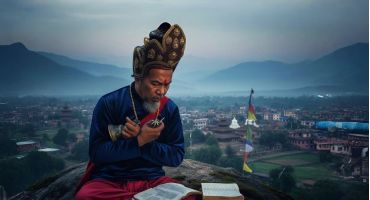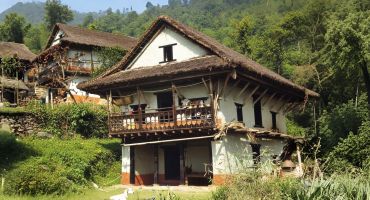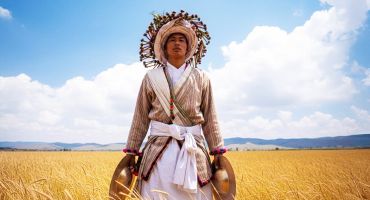In Darjeeling and Sikkim, one can rarely find a person who hasn’t seen a figure cloaked in intricate headgear, adorned with Rudraksha beads, deftly playing the hourglass-shaped drum (Damaru). Emerging from obscurity, he would vanish as mysteriously as he appeared, after having received alms. As children, his presence and attire both fascinated and unnerved us, stirring our imaginations. Known to our parents simply as “Kusule,” he upheld an unwavering vow of silence, shrouding himself in an aura of mystique that left us longing for answers that we never found.
The Kusule, also known as Kusle, Kusulya, Jugi, or Kapaali, are ritual specialists who occupy a unique and often marginal position within the stratified social hierarchy of the Newar community in the Kathmandu Valley. Traditionally ascetic, they follow a path of renunciation that places them at the edges of social life, yet their spiritual role grants them a distinctive authority. This combination of marginality and influence reflects the complex ways in which Newar society negotiates boundaries between the sacred and the social.
Newar social structure is characterized by a finely layered caste system, intensely influenced by both Hindu and Buddhist cosmologies. Within this intricate framework, the Kusule occupy a distinctive niche. They serve as ritual musicians and ceremonial functionaries, particularly in rites associated with death, spirit possession, and purification. Their ritual authority derives in part from their perceived proximity to the liminal: the threshold spaces between life and death, purity and pollution, revered and profane.
Their practices and iconography reveal historical affinities with heterodox sects such as the Kapalika and Gorakhnathi, esoteric traditions known for their austere, tantric disciplines that transgress normative religious boundaries. Yet, the Kusule remain firmly situated within the ritual economy of the Newar world. Far from being outsiders, they are an enduring part of a religious system that embraces both conformity and defiance in its ceremonial practices.
The name Kusle derives from Kus grass (Desmostachya bipinnata), a sacred plant regularly used in South Asian ritual traditions. This simple blade of grass carries powerful symbolic weight, linked to creation myths and purification rites. Additionally, Newar folklore traces the Kusule lineage to Kusalnath, one of the twelve disciples of the tantric master Gorakhnath, connecting the name to an ancient yogic tradition. Another story recounts how a Kapaali ascetic earned the title Kusle by being the swiftest to bring Kus grass to King Sthiti Malla, thereby establishing the name as an honorific within ritual circles. Thus, the term Kusule embodies both botanical symbolism and a historical lineage deeply rooted in ascetic and tantric traditions.

Inscriptions and historical texts from the Kathmandu Valley offer a window into the early presence and ritual importance of the Kusle-Kapaali within Newar society. As early as the 14th century, records point to figures closely aligned with Nath traditions (a Shaiva tantric yogic tradition rooted in asceticism and Hatha Yoga). An inscription from Itum Baha in 1382 mentions a minister devoted to Gorakhnath, while a 1390 record from Pharping documents the installation of Gorakhnath’s footprints by a yogi named Achintyanath, providing evidence of a spiritual landscape shaped by ascetic lineages. By the mid-15th century, inscriptions at the Kasthamandap shrine refer to ritual practitioners called Darsandhari, an early designation for the Kusle, who performed Chakrapuja, a complex tantric offering rite. These accounts suggest that the Kusle were once central figures in the Valley’s religious life, occupying sacred spaces where esoteric knowledge and public ritual converged.
Legal and social classifications in later periods reveal how the Kusle’s status shifted over time. The 1853 Muluki Ain, Nepal’s legal code under the Shah dynasty, lists the Kusalya among castes assigned to ritually impure roles, essential, yet socially marginalized. Earlier references by scholars and travelers, including D.R. Regmi and Francis Hamilton, describe communities known as Kusulay, Darsandhari, or Kasulia, serving as musicians, mendicants, and temple assistants. Their ritual authority, once affirmed through public ceremonies and temple affiliations, gradually diminished as royal patronage favored other ascetic orders, particularly the Kanphata (Kaan Chireko) Jogis. Yet the textual and epigraphic record preserves the imprint of their legacy as a social group rooted in Tantric traditions, once entrusted with navigating the spiritual boundaries of death, impurity, and transformation.
In contemporary practice, the Kusle occupy a pivotal role within the ritual landscape of the Newar community, primarily engaging in rites associated with death, purification, and spirit appeasement. As ritual specialists in mortuary practices, they oversee the preparation of corpses for cremation, conduct transitional ceremonies that facilitate the safe passage of the soul, and enact protective rites aimed at shielding both the deceased and the living from spiritual disturbance. These performances draw upon a repertoire of symbolic gestures and embodied knowledge rooted in Tantric cosmology, particularly those concerned with the containment of liminal energies and the pacification of potentially disruptive forces or ‘energies’. Positioned at the interstices of life and death, purity and danger, the Kusle serve as ritual mediators, navigating thresholds where the social order is most vulnerable to rupture.
A distinctive ritual unique to the Kusle involves a family member who, during the four winter months, from Bala Chaturdasi (mid-Mangsir) to Bikram Samvat New Year’s Eve (Chait), dons the appearance of Shiva. Covered in ashes, adorned with the Tripundra (three horizontal lines) on the forehead, wearing a diadem symbolizing the divine mothers, and necklaces of Rudraksha beads and human bones, a Kusle walks through the city streets at dawn carrying a hour-glass (damaru) drum. This procession is meant to expel harmful forces and purify the community, reinforcing their connection to Shiva and their role as powerful exorcists. Silence during these ceremonies further emphasizes their intimate relationship with the “dark” forces, serving as a ritual bridge that controls malevolent spirits without spoken words.

Among the Kusle, death rituals are shaped by a distinctive Tantric Shaiva worldview. Unlike other Newar castes that practice cremation, the Kusle perform inhumation, placing the deceased in Padmasana (seated meditation posture) facing north, toward Mount Kailasha, the mythic abode of Shiva. The ritual is conducted by a Kusle guru, who recites the mantra of Gorakhnath and performs Mṛitadikṣa, a post-death initiation meant to guide the soul, especially for those who died uninitiated. The burial mound is shaped as a Linga (sacred Shiva symbol), and ritual offerings are placed at four points: Kaagbali (for the crow), Pretbali (for the wandering soul), Svanbali (for the dog), and one for Gorakhnath himself. In the days that follow, the family performs Laapuja, a series of offerings involving water, rice, yogurt, vermillion, sesame, and flowers—first to Gorakhnath and then to the others. Through these rites, the Preta (the restless spirit of the recently deceased) is ritually transformed into a Pitr (an ancestral spirit acknowledged and venerated by the living).
Initiation into the Kusle tradition reflects these same liminal values. The process is led by a guru and includes the transmission of Gorakhnath’s mantra, an anointing with Panchagavya (five cow derivatives) a, and a symbolic Karnavedha: a ritual ear-piercing that gestures toward their ancestral link to the Kaanphata Jogis, though the ear is not actually split. The initiate is marked with ash and the sacred syllable Aum, and then enacts a symbolic journey to Varanasi, walking a path made of flour, cloves, and leaves laid out by the guru. This performance stands in for physical renunciation, signaling inner transformation within a household setting. Daily worship continues through a modest attic shrine to Gorakhnath, where offerings are made and roti (ritual bread) is prepared weekly. The Kusle’s ritual life, deeply embedded in Tantric practice yet adapted to Newar caste society, preserves a vision of sacred duty centered ritual mastery of its boundaries without impeding social perimeters.

In their social life, the Kusle occupy a distinctive position within Newar society as ritual musicians, traditionally responsible for playing sacred instruments during death rites and other ceremonies involving ritually impure forces. In the context of funerary practices, their music transcends mere performance; it becomes a medium of spiritual transformation, guiding the soul of the deceased while purifying the environment for the living. Their expertise in navigating the symbolic weight of death through sound marks the Kusle as custodians of a liminal domain where the sacred and the unclean converge.
Yet despite their indispensable ritual function, the Kusle remain socially marginalized. Their constant engagement with death and impurity, while vital to communal order, assigns them a low-caste status within the Newar caste hierarchy, subjecting them to social stigma that restricts both mobility and economic opportunity. In response to these constraints, many have adopted tailoring as a supplementary occupation which has become an adaptive strategy that complements their ritual role while providing a modest livelihood. This quiet fusion of sacred duty and secular labor reflects a resilient navigation of a world that relies on their presence yet offers limited recognition in return.
Many people confuse the Kusle with the Kaanphata Jogis, but the two are markedly different in both lifestyle and social integration. While the Kusle are linked to the Nath tradition and share certain symbolic and ritual features with the “split-eared” Jogis, such as associations with Shivaite tantra and practices around death, their paths diverge in significant ways. The Kaanphata Jogis live lives of strict asceticism, distinguished by physical signs of devotion like their split ears, which hold symbolic earrings of their sect. These ascetics typically renounce household life, travel widely, and position themselves outside the caste-based social systems of settled communities, following a rigorous path of personal spiritual discipline.
The Kusle, by contrast, have localized and adapted Nath traditions into the structure of Newar society. Rather than renouncing worldly life, they maintain family ties and fulfill hereditary ritual duties, including conducting funerary music, exorcisms, and rites surrounding death and impurity. They do not bear the marks of extreme asceticism, nor do they detach from community life. Today, the distinction is even more apparent. Since the Kusle are ethnically Newar, speak Nepal Bhasa (Newari), and embody Newar cultural identity. The Kaanphata Jogies whether celibate ascetics or born into the Jogi caste, are Parbatiya, aligned with the broader Indo-Nepalese Hindu framework and often affiliated with major Shivaite centers like Varanasi, Haridwar, and Kedarnath.
The ritual muteness of the Kusle is deeply symbolic, reflecting their role as intermediaries between the living and the spiritual realms. In Newar death rituals, where they handle potent forces associated with death and the spirit world, silence serves as a protective and purifying measure, allowing them to perform their duties without directly invoking or disturbing malevolent energies. Muteness aligns them with the Preta or wandering spirit, a being in transition and often unsatisfied, symbolizing the dangerous and unresolved aspects of death. By remaining silent, the Kusule embody a restraint that controls these forces, reinforcing their role in “containing” spiritual disturbances within ritual spaces. Silence thus becomes a shield that separates them from direct confrontation with these forces, allowing their presence to perform exorcistic functions subtly and effectively without verbal interaction.

In the shifting landscape of contemporary Himalayan region, the Kusle stand at a fragile crossroads, their ancient role as ritual musicians and death workers steadily dissolving into the margins of memory. Once bearers of sacred sound and mediators between realms, they now face growing irrelevance in a society that increasingly turns to sanitized forms of ritual and forgets the necessity of those who navigate the liminal. Modernity has offered few concessions as tailoring and low-paying labor now supplement their ritual services, but these new roles bring neither dignity nor security. Despite deep cultural lineage and societal importance, the Kusle continue to face caste-based stigma, economic hardship, and a fading recognition of their spiritual authority.
Nonetheless, their presence evokes something more enduring than marginalization. The Kusle embody the living palimpsest of Newar civilization, layered with influences from different traditions and cosmologies. Today, as the valley of Kathmandu modernizes and ritual worlds fragment, the Kusle’s quiet resilience reminds us of an older truth: that those who dwell closest to death often guard the deepest knowledge of life. To listen to their Damaru beat is to hear the echo of a civilization in dialogue with its own spirt.





Leave a Reply